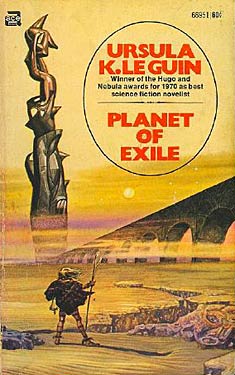Ursula K.
LeGuin
Completed 12/22/2018,
Reviewed 12/24/2018
4 stars
This is Le
Guin’s second published novel and the second in the Hainish Cycle. It’s a short easy read. It’s also the first book that feels like her
prose has come together for her. I didn’t
care so much for her prose in her first book, but this one felt like a Le Guin
novel. I also found the ending in this
book to be a little flat, ending abruptly.
However, my overall reaction to the book is much more positive, with the
plot and the prose working to create a decent novel.
This book
takes place on the planet Werel, seeded by the Hainish millennia ago. It is a pre-wheel society with multiple
races, the barbarians in the north and the more culturally advanced Tevarans in
the south. The planet has a large, highly eccentric orbit where their year is
equivalent to 60 of our years, and their seasons are like ours, but last
fifteen years each. Modern humans have
come to Werel, but have been stranded on the planet for 10 Years. That’s 600 of our years. They are the aliens, called “farborns” by the
Tevarans and are looked upon with suspicion as witches. However, they are dying out, with low birth
rates and failing technology.
Even though
the relationship between the Tevarans and the aliens is tentative at best, they
both have a common enemy, the Gaals, the barbarians of the north. Instead of their normal raids as winter
approaches, they have all united into one mighty army to conquer the Tevarans
and the aliens. The only chance the
Tevarans and farborn have is to unite and fight together. But because the Tevarans look upon the
farborn with suspicion, the alliance is very tentative and the slightest breach
of etiquette could destroy it. So when
the leader of the farborn and a granddaughter of the Tevaran ruler get
together, they walk on dangerous ground.
While the
book is about the relationship between Jakob Agat and Rolery, it is much more
an anthropological study about the coming together, though not quite clashing,
of different cultures. The farborn
mandate is not interfere with the development of the native peoples. Thus for six hundred years, the aliens have
watched as the Tevarans struggle without the wheel or almost any technology. Of course this becomes problematic as the
Gaals approach.
I give this
book four stars out of five. Even though
the ending wasn’t exactly satisfying, the prose really was. The world building was also pretty amazing,
with its seasons and interplay between the various strains of humanity.

No comments:
Post a Comment